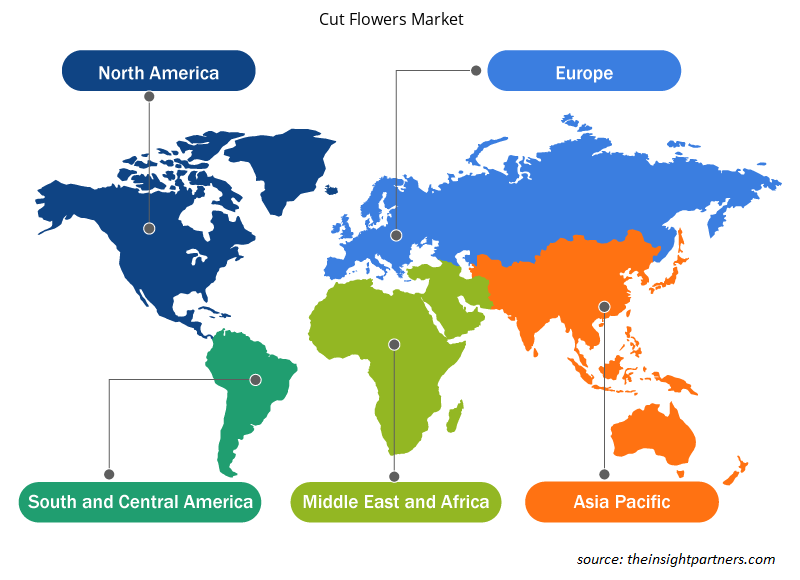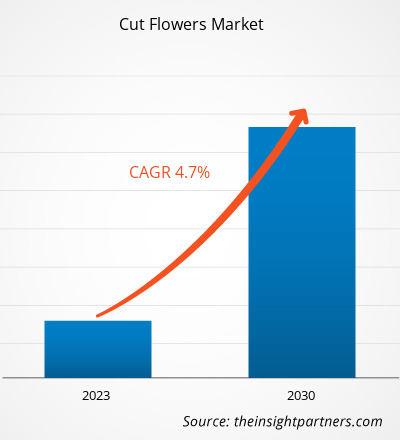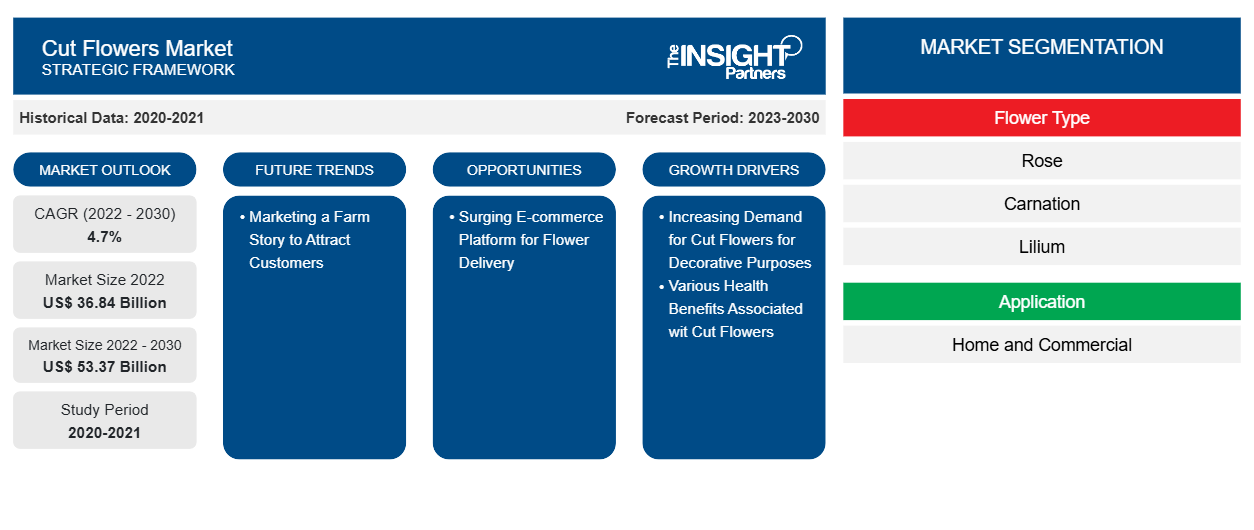[Forschungsbericht] Der Markt für Schnittblumen soll von 36.835,42 Millionen US-Dollar im Jahr 2022 auf 53.369,13 Millionen US-Dollar im Jahr 2030 wachsen; der Markt soll von 2022 bis 2030 eine durchschnittliche jährliche Wachstumsrate (CAGR) von 4,7 % verzeichnen.
Markteinblicke und Analystenansichten:
Schnittblumen sind Blüten oder Blütenknospen, die von der Pflanze, an der sie wachsen, abgeschnitten werden. Sie werden normalerweise von Pflanzen entfernt, um sie zu dekorativen Zwecken zu verwenden. Die meisten Gärtner ernten ihre Schnittblumen in ihren Gärten, aber in den meisten Ländern gibt es eine Blumenindustrie, die sich auf Schnittblumen spezialisiert hat. Die Pflanzen, von denen die Schnittblumen abgeschnitten werden, unterscheiden sich je nach Klima, Kultur und lokalem Wohlstand. Meistens werden die Pflanzen für Schnittblumen auf separaten Feldern oder in Gewächshäusern angebaut. Der Anbau von Schnittblumen ist intensiv, da große Mengen hochgiftiger Pestizide und Rückstände erforderlich sind.
Wachstumstreiber und Herausforderungen:
Schnittblumen werden zu Dekorationszwecken verwendet. Sie werden in Vasenarrangements und Blumensträußen bei formellen Veranstaltungen und informellen Ausstellungen verwendet, um Häuser und öffentliche Plätze zu verschönern, sowie für Designs für Hochzeiten und Beerdigungen, Ansteckblumen, Kränze, ähnliche Ziergegenstände und Boutonnieren. Die Event- und Hochzeitsplaner verwenden verschiedene Blumen als Dekoration, für Blumensträuße und Tafelaufsätze und schaffen so einen kreativen Veranstaltungsraum. Laut der Knot Real Wedding Study betrugen die durchschnittlichen Investitionskosten für Hochzeitsblumen im Jahr 2022 2.400 US-Dollar. Darüber hinaus hat die steigende Nachfrage von Event- und Hochzeitsplanern nach exotischen und saisonalen Blumen für florale Dekorationen zur Verbesserung der Raumästhetik weiter zum Marktwachstum beigetragen.
Schnittblumen werden aufgrund ihrer vielfältigen gesundheitlichen Vorteile für medizinische Zwecke verwendet. Blumen haben bekanntermaßen einen unmittelbaren Einfluss auf die Stimmung. Ihre leuchtenden Farben und angenehmen Düfte können helfen, Stress, Angst und Depressionen zu reduzieren und das geistige Wohlbefinden zu verbessern. Studien haben gezeigt, dass Blumen den Cortisolspiegel (ein Stresshormon) senken können, was zu weniger Stress und einem entspannteren Lächeln führt. Eine von der Harvard Medical School durchgeführte Studie zeigte beispielsweise, dass Menschen sich weniger Sorgen machen, wenn sie zu Hause Blumen haben, was zu weniger Angst und Depression führt.
Schnittblumen unterliegen verschiedenen gesetzlichen und außergesetzlichen Anforderungen. Der internationale Handel mit Schnittblumen ist häufig mit einer umfangreichen Dokumentation verbunden, darunter Pflanzengesundheitszeugnisse , Zollerklärungen und Genehmigungen. Die strikte Einhaltung dieser Anforderungen ist für den grenzüberschreitenden Handel erforderlich. Beispielsweise müssen in europäischen Ländern die Pflanzengesundheitsanforderungen der Käufer sowie die Produktkennzeichnung und Verpackungsanforderungen strikt eingehalten werden. Die Europäische Union hat Pflanzengesundheitsanforderungen festgelegt , um die Verbreitung und Einschleppung schädlicher Organismen aus Pflanzenprodukten in der Region zu verhindern. In die EU exportierte Schnittblumen müssen den EU-Vorschriften zur Pflanzengesundheit entsprechen. Die meisten in die Europäische Union importierten Blumen müssen von einem offiziellen „ Pflanzengesundheitszeugnis “ begleitet sein, das garantiert, dass der Pflanzengesundheitszustand der Pflanzen und Pflanzenprodukte sowie der Sendung amtlich geprüft wurde. Es muss den gesetzlichen Anforderungen für die Einfuhr in die Europäische Union entsprechen und frei von Quarantäneschädlingen und anderen schädlichen Krankheitserregern sein.
Passen Sie diesen Bericht Ihren Anforderungen an
Sie erhalten kostenlos individuelle Anpassungen an jedem Bericht, einschließlich Teilen dieses Berichts oder einer Analyse auf Länderebene, eines Excel-Datenpakets sowie tolle Angebote und Rabatte für Start-ups und Universitäten.
-
Holen Sie sich die wichtigsten Markttrends aus diesem Bericht.Dieses KOSTENLOSE Beispiel umfasst eine Datenanalyse von Markttrends bis hin zu Schätzungen und Prognosen.
Berichtssegmentierung und -umfang:
Der globale Markt für Schnittblumen ist nach Blumenart, Anwendung, Vertriebskanal und Geografie segmentiert. Basierend auf der Blumenart ist der Markt für Schnittblumen in Rosen, Nelken, Lilien, Chrysanthemen und Gerbera und andere unterteilt. Basierend auf der Anwendung ist der Markt in Privat- und Gewerbekunden unterteilt. Basierend auf dem Vertriebskanal ist der Markt für Schnittblumen in Supermärkte und Hypermärkte, Fachgeschäfte/Floristen, Online-Einzelhandel und andere unterteilt. Geografisch ist der Markt in Nordamerika (USA, Kanada und Mexiko), Europa (Deutschland, Frankreich, Italien, Großbritannien, Russland und das übrige Europa), Asien-Pazifik (Australien, China, Japan, Indien, Südkorea und der restliche Asien-Pazifik-Raum), den Nahen Osten und Afrika (Südafrika, Saudi-Arabien, die Vereinigten Arabischen Emirate und der restliche Nahe Osten und Afrika) und Süd- und Mittelamerika (Brasilien, Argentinien und der restliche Süd- und Mittelamerika) segmentiert.
Segmentanalyse:
Je nach Anwendung ist der Markt für Schnittblumen in private und gewerbliche Anwendungen unterteilt. Das gewerbliche Segment hält einen erheblichen Marktanteil. Schnittblumen werden hauptsächlich als Dekoration bei Hochzeiten, Geburtstagsfeiern, Beerdigungen, in Geschäftsräumen, Hotels, Industrieanlagen usw. verwendet. Darüber hinaus verwenden Hotels, Restaurants und Resorts häufig Schnittblumen, um ihr Ambiente zu verbessern. Die steigende Nachfrage nach frischen Blumenarrangements für Veranstaltungen und Feiern und die wachsende Vorliebe für einzigartige und exotische Blumensorten haben das Wachstum des Marktes für Schnittblumen für gewerbliche Anwendungen vorangetrieben. Trends wie übergroße Blumeninstallationen, hängende Blumenarrangements und einzigartige und farbenfrohe Blumenkombinationen kommen dem Markt für gewerbliche Anwendungen zusätzlich zugute.
Regionale Analyse:
Der Markt für Schnittblumen ist in fünf Hauptregionen unterteilt: Nordamerika, Europa, Asien-Pazifik, Süd- und Mittelamerika sowie Naher Osten und Afrika. Der globale Markt für Schnittblumen wurde von Europa dominiert; der Markt in dieser Region wurde im Jahr 2022 auf 253,01 Millionen US-Dollar geschätzt. Nordamerika ist der zweitgrößte Marktteilnehmer und hält etwa 31 % des Weltmarkts. In Nordamerika sind viele in- und ausländische Akteure wie Washington Bulb Co., Inc., Oserian und Dümmen Orange auf dem Markt für Schnittblumen tätig. Diese Unternehmen arbeiten ständig daran, die Eigenschaften und Qualitäten von Schnittblumen zu verbessern, um neue Verbraucher anzuziehen und ihre Verbraucherbasis zu erweitern. Die größte Nachfrage nach Schnittblumen entsteht an Tagen wie Valentinstag, Muttertag, Weihnachten und Ostern, da die Menschen Blumen als Geschenke verwenden, um ihre Gefühle auszudrücken und diese besonderen Anlässe zu feiern. Auch die Hochzeits- und Eventbranche treibt die Nachfrage nach Schnittblumen an. Paare und Eventplaner verwenden Schnittblumen in Dekorationen, Sträußen und Tafelaufsätzen. Laut der Knot Real Wedding Study betrug der durchschnittliche Betrag, der im Jahr 2022 in Hochzeitsblumen investiert wurde, 2.400 US-Dollar.
Branchenentwicklungen und zukünftige Chancen:
Nachfolgend sind verschiedene Initiativen wichtiger Akteure auf dem Schnittblumenmarkt aufgeführt:
- Im Jahr 2022 gaben Selecta One und Moraglia Breeding gemeinsam bekannt, dass die beiden Unternehmen eine neue formelle strategische Allianz eingegangen sind. Dieser strategische Partner stärkt die Logistikkapazitäten und das Know-how erheblich, einschließlich einer starken Strategie, Lieferkette und Teamführung.
Regionale Einblicke in den Markt für Schnittblumen
Die regionalen Trends und Faktoren, die den Schnittblumenmarkt im Prognosezeitraum beeinflussen, wurden von den Analysten von Insight Partners ausführlich erläutert. In diesem Abschnitt werden auch die Marktsegmente und die Geografie des Schnittblumenmarkts in Nordamerika, Europa, im asiatisch-pazifischen Raum, im Nahen Osten und Afrika sowie in Süd- und Mittelamerika erörtert.

- Erhalten Sie regionale Daten zum Schnittblumenmarkt
Umfang des Marktberichts über Schnittblumen
| Berichtsattribut | Details |
|---|---|
| Marktgröße im Jahr 2022 | 36,84 Milliarden US-Dollar |
| Marktgröße bis 2030 | 53,37 Milliarden US-Dollar |
| Globale CAGR (2022 - 2030) | 4,7 % |
| Historische Daten | 2020-2021 |
| Prognosezeitraum | 2023–2030 |
| Abgedeckte Segmente |
Nach Blumenart
|
| Abgedeckte Regionen und Länder |
Nordamerika
|
| Marktführer und wichtige Unternehmensprofile |
|
Dichte der Marktteilnehmer für Schnittblumen: Die Auswirkungen auf die Geschäftsdynamik verstehen
Der Markt für Schnittblumen wächst rasant, angetrieben durch die steigende Nachfrage der Endverbraucher aufgrund von Faktoren wie sich entwickelnden Verbraucherpräferenzen, technologischen Fortschritten und einem größeren Bewusstsein für die Vorteile des Produkts. Mit der steigenden Nachfrage erweitern Unternehmen ihr Angebot, entwickeln Innovationen, um die Bedürfnisse der Verbraucher zu erfüllen, und nutzen neue Trends, was das Marktwachstum weiter ankurbelt.
Die Marktteilnehmerdichte bezieht sich auf die Verteilung der Firmen oder Unternehmen, die in einem bestimmten Markt oder einer bestimmten Branche tätig sind. Sie gibt an, wie viele Wettbewerber (Marktteilnehmer) in einem bestimmten Marktraum im Verhältnis zu seiner Größe oder seinem gesamten Marktwert präsent sind.
Die wichtigsten auf dem Schnittblumenmarkt tätigen Unternehmen sind:
- Die Queen's Flowers Corp
- Selecta Schnittblumen SAU
- Sher Holland BV
- Multiflora Corp
- Rosebud GmbH
Haftungsausschluss : Die oben aufgeführten Unternehmen sind nicht in einer bestimmten Reihenfolge aufgeführt.

- Überblick über die wichtigsten Akteure auf dem Schnittblumenmarkt
Auswirkungen der COVID-19-Pandemie:
Die COVID-19-Pandemie hatte Auswirkungen auf die Wirtschaft und Industrie in zahlreichen Ländern. Lockdowns, Reiseverbote und Betriebsschließungen in führenden Ländern Nordamerikas, Europas, des asiatisch-pazifischen Raums, Süd- und Mittelamerikas sowie des Nahen Ostens und Afrikas wirkten sich negativ auf das Wachstum zahlreicher Branchen aus, darunter auch der Konsumgüterindustrie. Die Schließung von Produktionsstätten störte die globalen Lieferketten, Fertigungsaktivitäten, Lieferpläne und den Verkauf verschiedener lebensnotwendiger und nicht lebensnotwendiger Produkte. Verschiedene Unternehmen kündigten mögliche Verzögerungen bei Produktlieferungen und einen Einbruch der zukünftigen Verkäufe ihrer Produkte im Jahr 2020 an. Darüber hinaus zwangen die von verschiedenen Regierungen in Europa, dem asiatisch-pazifischen Raum und Nordamerika verhängten Verbote für internationale Reisen die Unternehmen dazu, ihre Pläne für Zusammenarbeit und Partnerschaften auf Eis zu legen. All diese Faktoren behinderten die Konsumgüterindustrie im Jahr 2020 und Anfang 2021 und bremsten das Wachstum des Schnittblumenmarktes.
Wettbewerbslandschaft und Schlüsselunternehmen:
Zu den führenden Akteuren auf dem globalen Schnittblumenmarkt zählen The Queen's Flowers Corp, Selecta Cut Flowers SAU, Sher Holland BV, Multiflora Corp, Rosebud Ltd, Karen Roses Ltd, Washington Bulb Co Inc, Dummen Orange Holding BV, Esmeralda Farms LLC und Marginpar BV. Diese Marktteilnehmer ergreifen strategische Entwicklungsinitiativen, um zu expandieren und das Marktwachstum weiter voranzutreiben.
- Historische Analyse (2 Jahre), Basisjahr, Prognose (7 Jahre) mit CAGR
- PEST- und SWOT-Analyse
- Marktgröße Wert/Volumen – Global, Regional, Land
- Branchen- und Wettbewerbslandschaft
- Excel-Datensatz
Aktuelle Berichte
Erfahrungsberichte
Grund zum Kauf
- Fundierte Entscheidungsfindung
- Marktdynamik verstehen
- Wettbewerbsanalyse
- Kundeneinblicke
- Marktprognosen
- Risikominimierung
- Strategische Planung
- Investitionsbegründung
- Identifizierung neuer Märkte
- Verbesserung von Marketingstrategien
- Steigerung der Betriebseffizienz
- Anpassung an regulatorische Trends























 Kostenlose Probe anfordern für - Markt für Schnittblumen
Kostenlose Probe anfordern für - Markt für Schnittblumen